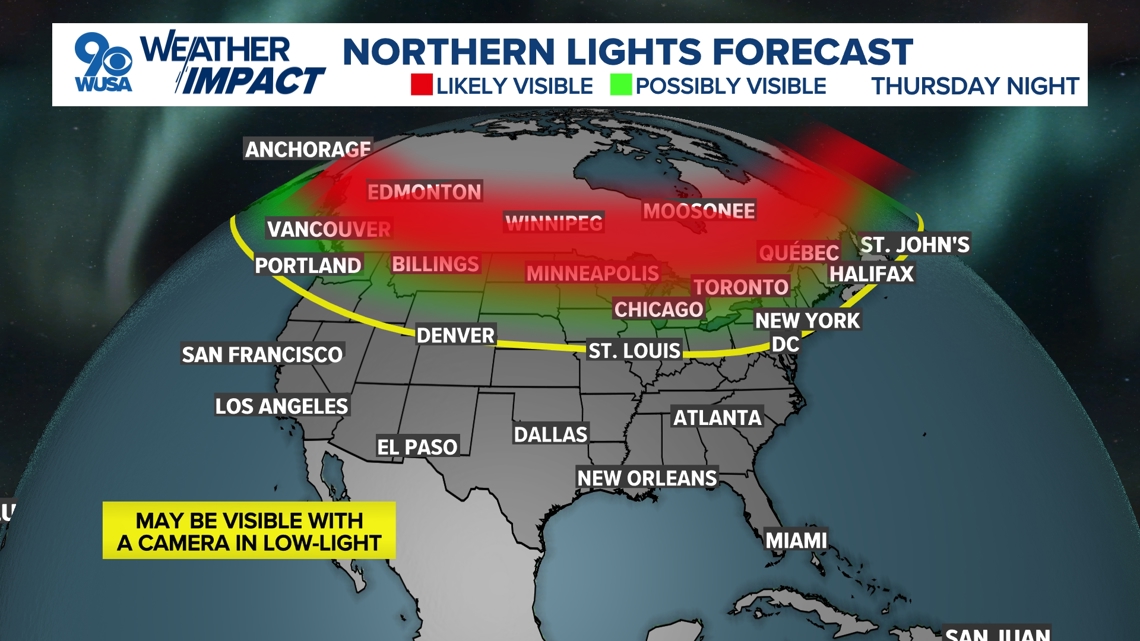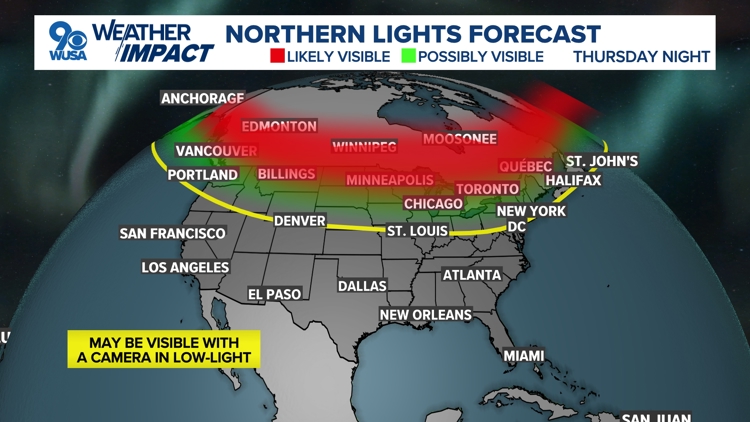WASHINGTON — A powerful geomagnetic storm is possible Thursday and Friday that will likely make the northern lights visible across parts of the northern United States, including here in parts of the DMV!
The solar storm could stress power grids even more as the U.S. deals with major back-to-back hurricanes according to space weather forecasters.
The National Oceanic and Atmospheric Administration's Space Weather Prediction Center is forecasting the likelihood of a G4 geomagnetic storm. That is the second-highest level on the SWPC's scale which accounts for both severity and potential impacts.
Geomagnetic Storm Scale:
- G1 - Minor: Minor power grid impacts possible and auroras in higher latitudes
- G2 - Moderate: Power grid impacts at poles and auroras visible in northern U.S.
- G3 - Strong: Minor GPS and satellite impacts with auroras visible through the Great Lakes
- G4 - Severe: Power voltage issues and severe GPS interference. Auroras visible farther south in the U.S.
- G5 - Extreme: Power grid failures and satellite malfunction. Auroras seen as far south as the Caribbean.
There was last a G4 storm warning back in May, when the aurora was seen across the northern half of the United States. Prior to May, the last G4 storm warning was back in 2005.
NOAA has notified operators of power plants and orbiting spacecraft to take precautions. It also alerted the Federal Emergency Management Agency about possible power disruptions, as the organization copes with the devastating aftermath of Hurricane Helene and Hurricane Milton.
Florida is far enough south to avoid any power disruptions from the solar surge unless it gets a lot bigger, said scientist Rob Steenburgh of NOAA’s SWPC.
“That adds a little bit more to the comfort level,” Steenburgh said. "Why we're here is to let them know so that they can prepare."
Experts are more concerned about potential effects to the power grids in areas slammed by Hurricane Helene two weeks ago, said NOAA space weather forecaster Shawn Dahl.
Forecasters do not expect the latest solar storm to surpass the one that slammed Earth in May, the strongest in more than two decades.
What causes solar storms?
A massive explosion from the sun! The solar flare first seen on Tuesday, Oct. 8, was accompanied by a coronal mass ejection, which is a large eruption of solar particles and magnetic fields. That CME is directed toward Earth and forecast to trigger the powerful G4 storm.
If it seems like we've been talking about auroras more frequently, it's because we are in the period of the 11-year solar cycle known as solar maximum. During this time, sunspot activity is heightened and there are more opportunities for space weather events, like coronal mass ejections that produce the aurora.


The best chance to see the aurora around D.C. will be in areas north of I-66 and especially in areas closer to I-81, away from light pollution. You may be able to see some color with your eyes, but you have a better chance of seeing them by taking a photo.
Use a camera or your phone to take a long exposure photo for several seconds. Try and steady your camera or use a tripod for best results. The camera may be able to see aurora your eyes cannot.
Thursday night is your best bet to see the light show in the sky, but the northern lights may still be visible Friday night.



